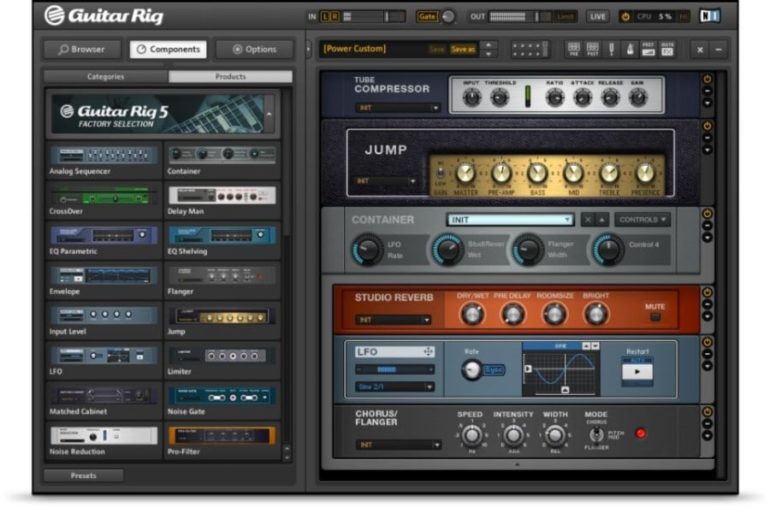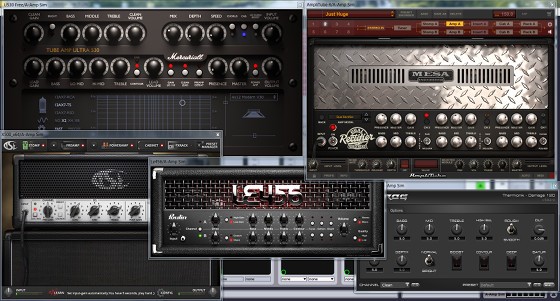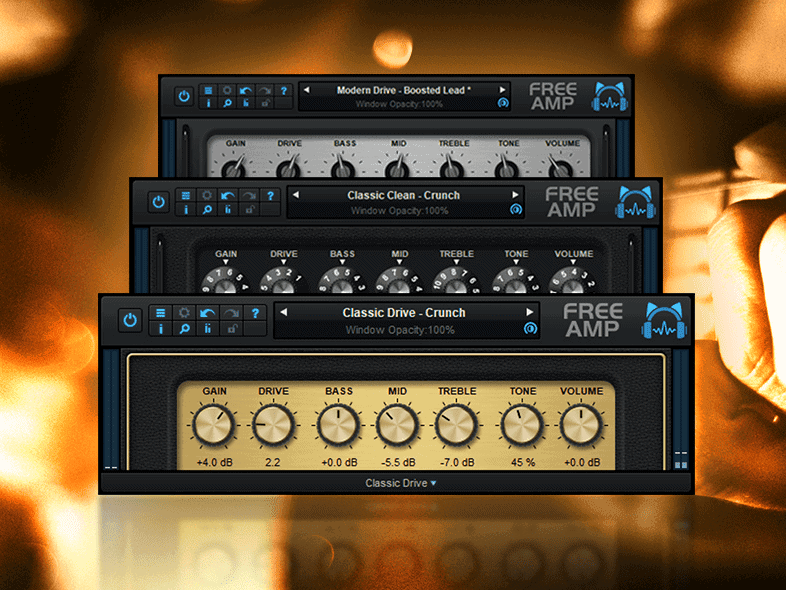Good Metal Tone Guitar Amp Sim Vst Plugin
- Good Metal Tone Guitar Amp Sim Vst Plugins
- Good Metal Tone Guitar Amp Sim Vst Plugin Plugins
- Good Metal Tone Guitar Amp Sim Vst Plugin Download
Using software amplification simulators, or amp sims for short, is becoming increasingly popular. The benefits are many, you can tweak your sound endlessly, switch between different amp sims trying to find the best tone for your song. A drawback is that an amp sim not properly tuned can generate digital artifacts giving away that it’s not a perfectly recorded physical amplifier. Here’s how to get a great guitar tone!

These days, all you need is a killer VST plugin along with some impulses to achieve stellar results. In some cases, you don’t even need impulses. If that wasn’t awesome enough, you can even get some great sounding VSTs for free. That’s what we’re going to be looking at in this guide – free guitar VST plugins that sound ultra-realistic. For me the best plugins for guitar now are: 1.steinberg’s vst amp rack 2.studio devil amp mercuriall jcm800 & harlequin 3.brainworx rockrack 4.the free ones like lepou legion the TSE plugins are good, or those of Ignite amps 6.overloud th2 7.IK amplitube 3 8.guitar rig 5 jamvox revalver. Guitar Amp 2 by Plektron is a fabulous guitar effects suite that comes with an inbuilt British amp, cabinet simulator and a thumping bass amp to cater to guitarists of all hues. What makes it one of the best free VST plugins is that it offers an all-around compact sound which can be laid over your guitar tracks without any tweaks. An amp sim plugin in an appropriate format (VST for most DAWs), such as one of LePou’s plugins. An speaker cabinet impulse file, such as one of Catharsis impulses. An impulse loader plugin, such as LePou’s LeCab2. A tubescreamer simulator plugin, such as TS-999. Line 6- Helix Native- Our High End Choice. Last but not least, we have the Line 6’s Helix Native. This is a great model to get that vintage rock sound, perhaps even the best amp simulator on this list. It’s priced on the high-end though and not exactly beginner friendly, so unless you have some experience under your belt, we’d recommend trying out an easier to use guitar amplifie.
What you need
- A music production application (DAW), such as Reaper, Cubase, Logic or Pro Tools.
- An amp sim plugin in an appropriate format (VST for most DAWs), such as one of LePou’s plugins.
- An speaker cabinet impulse file, such as one of Catharsis impulses.
- An impulse loader plugin, such as LePou’s LeCab2.
- A tubescreamer simulator plugin, such as TS-999.
- Two good dry guitar recordings of the same rhythm parts. The closer they are the better, but you can’t use the same recording twice by just duplicating one take.
The TPA-1 is meant to be used as a guitar tube power amplifier simulator for live playing and jamming, tracking or mixing inside hosts capable of VST or AU Plug-Ins support. Dynamic EL34 / 6L6GC / KT88 pentodes/tetrodes analog modeling (push-pull stage) Dynamic ECC83 / 12AX7 triode analog modeling (phase inverter stage).
Some Tips
The biggest trick in getting a great guitar tone from any digital amplifier software is not to use too much gain. It’s much better to use an overdrive in front to get a tighter sound from the amp than cranking up the gain, since amp sims usually get fizzier and generate artifacts compared to a physical tube amp.
I always double track my rhythm guitars. Two identical takes (or – as similar as I can get them) panned completely left and right. This makes the guitar sound fill out the stereo space, making the sound much bigger and leaving space in the middle for other instruments and guitar leads.
Hands on
Create two tracks, one for each guitar take. Pan the two tracks completely left and right respectively. Starting with one of the tracks, add the TubeScreamer sim to the FX chain. Make sure it’s set to high quality/high multiple oversampling. Turn gain all the way down to zero and level to max. This way the TS will push the signal without distorting it. Turn the tone to your liking, I usually leave it flat in the middle.
Next, add your amp sim. I’m using Legion, which unlike most other amp sims, isn’t actually based on a real amp (it’s LePou’s own brainchild). It’s tighter than the Lecto and a little less fizzy in the higher registers. I’m using the red channel (high gain) and I’ve rolled down the gain a bit. I could probably go lower still… I’ve set it for high quality and stereo (since I use a single bus for both guitar tracks – but thats the advanced class). I’ve kept most settings pretty default, but I’ve boosted the mids slightly along with presence and contour.
Last I set up the cab impulses. I use Lecab2 for loading impulses. I’ve set up two identical cabs for right and left (again, that’s the master class). Instead of applying high and low passes with EQ I usually use the built in filters in the cab loader, removing anything lower than 70 Hz and anything higher than 11 kHz. Remember, it’s always better to remove bad stuff than trying to boost good stuff.
Lastly, apply EQ and reverb as appropriate. For my example I didn’t use any of either. Here’s my lab tone:
I’m going to tweak it further, probably dial down the gain a bit further.

UPDATE: Here’s a song so you can hear what it sounds like in a mix:
Related posts:
Editor’s Note: In this article, we’ll go into the best amp simulator VST plugins in the market as of 2020. If you’re looking for the summarised version, check out the table below, for a full breakdown, read on:
Product | Amps simulated | Price |
| Positive Grid Bias FX 2 | Over 100. Check full list here | Under 100$CHECK PRICE |
| Overloud TH3 | Over 200. Check full list here | 200$ to 300$CHECK PRICE |
| IK Multimedia Amplitube 4 | 145 different amp sims. Full list here | 200$ to 300$CHECK PRICE |
| Native Instruments Guitar Rig 5 | 7 amps, 27 cabinets, 54 effects. Full list here | 100$ to 200$CHECK PRICE |
Whatever musical direction you’re taking, there’s a high chance you’ll be using at least some distortion.

This effect was popularized back in the old days by blues and rock ‘n’ roll guitar players, who sometimes even damaged their equipment to get this tone.
Luckily for us today, achieving distortion is not that hard, and there are plenty of safe and affordable ways of doing it.
Of course, the first association is often the guitar-oriented music, but great-sounding distortion can be found even in electronic music.
Even EDM musicians resort to using guitar effects, actual distortion pedals or guitar amp sims.
But if we’re talking about music production, mixing, and working in any DAW, it’s definitely easier and way more practical to rely on plugins.
Sometimes, you can get some pretty great guitar tones, for whatever purposes, by using some great amplifier simulation plugins.
Good Metal Tone Guitar Amp Sim Vst Plugins
Whether you’re a guitar player, bassist, DJ, instrumentalist, or even a vocalist – here are the best amp sims for you to check out.
Although mostly focused on guitar-oriented music, you’re always free to experiment and use them for other purposes as well. Here it goes.
Positive Grid – Bias FX 2– Our Overall Choice
A new amp simulator by Positive Grid, the Bias FX 2 amp sim brings a whole universe of options in creating one’s tone.
It’s not a product focused on limited types of tones and musicians.
The newest in the Bias amp series brings an abundance of different amps, cabinet simulations, pedals, and microphones, all extremely realistically representing the respective models that they’re imitating.
There’s a wide variety of high gain amps for our metalhead readers, as well as a bunch of experimental effects to get your creative juices flowing.
Talking about amps and cabinets, Positive Grid teamed up with Celestion to bring digital replicas of the legendary speakers found in many of the prestigious cabinets. You can check the full list of amps here.
Overall, the Bias FX 2 brings some pretty advanced stuff with a surprisingly simple operation, making our favorite amp sim in the market right now.
It comes as a great option for any level of playing and musicianship. Even beginners will find it easy to use, and the Bias amp can be a great way for them to get acquainted with the world of guitar amps and pedals.
It’s also one of the most affordable VST plugins in this list, and includes a free demo.
Check out the video review below:
Overloud – TH3– Simple but Effective.
Overloud’s TH3 amp simulator and plugin works in a similar way compared to the Bias, with a bunch of amp, cabinet, pedal, and mic models.
When it comes to guitars, there are 89 different amps, as well as 50 cabinets. Bass players, however, don’t have that many options, since there are only 4 bass amplifier models and 2 bass cabinet models.
Going over to the pedals and other effects, there are 77 different emulations to choose from. The choice of microphones is decent, with 18 different models and the possibility to choose up to 4 mics per one cabinet.
In total, there are 1000 different presets that will help you get great amp simulations right out of the box.
What’s more, Overloud collaborated with some of the famous amp brands, including Randall, to recreate their guitar tones.
Ignite Amps – Emissary– Our Free Choice
Ignite Amps have a few interesting solutions for amp simulators, all of them giving some really solid tones, both for Clean and Distorted situations.
The one we found worth mentioning on this list is the Emissary plugin, a super fun high gain amp.
Although focusing on just one amp model, it still provides a solid amount of possibilities and great tube-oriented modern metal tones.
The physical amp that it replicates is also called Emissary and was made by Ignite for Ryan Huthnance.
It may not be as versatile as some of the other plugins here, but its strength lies in a very realistic representation of this tube amp.
It has two channels, Clean and Drive, along with standard controls and some additional switches for additional EQ shaping.
And the best part?
It’s free!
IK Multimedia – AmpliTube 4– Our Mic Amp Simulator Choice
Made by IK Multimedia, AmpliTube has been around for quite some time now.
The fourth installment in the series takes things to a whole new level, with some of the modern guitar heroes expressing their admiration for this plugin.
An abundance of great amps of all the different eras of modern music, stompbox models, cabinet models, mic models, as well as possibilities to create intricate and non-linear signal chains.
Things get pretty interesting with the virtual microphone and cabinet placement, providing some very realistic-sounding amplifier tones. You can place microphones in virtual 3D settings, which is a pretty exciting feature.
Universal Audio – Fender 55 Tweed Deluxe
Now, this plugin is a little different. First off, it focuses on just one amp which, expectedly, limits its versatility and leaves you with not many options. However, this was actually Universal Audio’s intention, to have just one amp and recreate it as realistically as possible.
The piece in question is Fender’s good old vintage gem, the ’55 Tweed Deluxe. This plugin was done in collaboration with Fender, who helped them out in digitally recreating this amp’s legendary circuitry.
It may have somewhat of a narrow use, mostly those who are looking for those sparkly vintage-oriented blues tone.
But the recreation is just astoundingly realistic, coming very close to the original. Take the good old Tweed Deluxe and mic it up with different microphone simulations.
Studio Devil – Amp Modeler Pro
Although intended for guitars, the Amp ModelerPro by Studio Devil will also give great amp models, distortions, and othereffects for electronic music makers as well.
There are about 15 different preamps that come with it, 32 cabinets, plenty of different pedals and rack-mounted effects, as well as different controls and elaborate EQs.
It’s a somewhat cheaper option compared to the other entries on this list, although it definitely manages to convincingly reproduce classic and modern amplifier tones.
Native Instruments – Guitar Rig 6– Our Overall #2 Choice
October 2020 update: Native Instruments just announced the new version of Guitar Rig- V6.
Guitar Rig 6 comes with a new interface, pictured below, more effects, and new AI tech.
It’s been almost 5 years since the latest update to guitar rig, so the expectations were high within the music production community, and in our opinion, the new version lives up to the hype.
Good Metal Tone Guitar Amp Sim Vst Plugin Plugins
The first thing you’ll notice with Guitar Rig 6 is it’s brand new interface. It’s looking way cleaner and simpler to use.
In addition, 16 new effects were added, including the following softube amps: RC24, RC48, CV2A, VC2A, VC76, and CC160.
All in all, Native Instruments Guitar Rig 6 is one of the most diverse guitar amp sims at the moment.
At the same time, it’s very accessible and is one of the best options for beginners who want to learn more about amplifiers, cabinets, pedals, and other effects and units.
Comparable to AmpliTube and Bias products, there’s a fair amount of amp and cabinet simulations with more than 50 effects and an option to use up to 8 different microphone models on one cabinet at the same time.
This is one of the Native Instrument’s most popular products.
Line 6- Helix Native- Our High End Choice
Last but not least, we have the Line 6’s Helix Native.
This is a great model to get that vintage rock sound, perhaps even the best amp simulator on this list. It’s priced on the high-end though and not exactly beginner friendly, so unless you have some experience under your belt, we’d recommend trying out an easier to use guitar amplifier simulator such as the Bias FX 2.
However, if you do know what you’re doing, the Line 6 is a great piece of software.
It includes over 100 effects and 60 amps, including some of the legendary amps used by Hendrix et al (Mesa Boogie, etc).
If you’d like to have a go at the Helix Native, Line 6 does offer a 15 day free version.
Final Thoughts and Overall Winner
And there you have it, the very best amp simulator available for purchase right now.
Combined, they represent thousands of amps, cabinets, and stompboxes.
Good Metal Tone Guitar Amp Sim Vst Plugin Download
So take your time, read about the amps offered by each, and make your decision. If you’re looking for an expert opinion- We’d go with the Positive Grid Bias FX 2
Rock on!